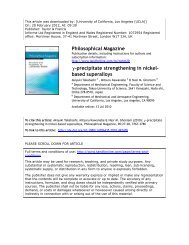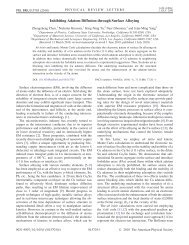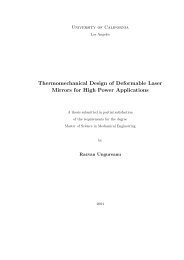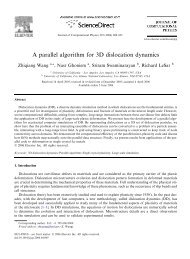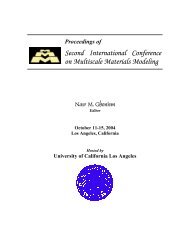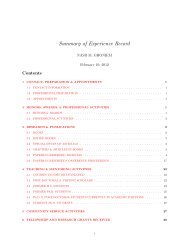FS&T Template - Nasr Ghoniem's Matrix Laboratory - UCLA
FS&T Template - Nasr Ghoniem's Matrix Laboratory - UCLA
FS&T Template - Nasr Ghoniem's Matrix Laboratory - UCLA
You also want an ePaper? Increase the reach of your titles
YUMPU automatically turns print PDFs into web optimized ePapers that Google loves.
Sharafat et al.<br />
SiC-FOAM BASED FLOW CHANNEL INSERT FOR DCLL TBM<br />
Chemical vapor infiltrated (CVI) open-cell SiC-foam<br />
was proposed as a candidate porous SiC material with<br />
dense CVD SiC closeout face sheets. Production of SiCfoam<br />
materials is a relatively mature technology, which<br />
(Ref. 7) and SiC foam<br />
structures with a variety of geometric configurations are<br />
now commercially available. 8 The primary advantage of<br />
using this technology is that all SiC materials are<br />
CVD/CVI based, which have been shown to have<br />
excellent radiation damage resistance, thermal stability,<br />
and chemical compatibility with PbLi.<br />
In this paper, we outline performance and material<br />
requirements of a SiC-based FCI structure, followed by<br />
the design of a prototypical FCI structure. Next, results of<br />
static thermo-mechanical analyses of a SiC-foam based<br />
FCI under ITER operating conditions are presented.<br />
Development and testing of SiC-foam based FIC material<br />
samples are discussed, and fabrication of 30 cm long<br />
prototypical FCI components are reported. We conclude<br />
with the results of first thermal exposure tests and planned<br />
liquid metal exposure tests of the complete FCI segments.<br />
II. FCI KEY PERFORMANCE REQUIREMENTS<br />
A number of performance requirements have to be<br />
met by the FCI structure, which include compatibility<br />
with high temperature PbLi, low through the thickness<br />
thermal conductivity, and low through the thickness<br />
electrical conductivity. However, specific required<br />
material properties depend on the reactor design (ITER,<br />
DEMO), the FCI design itself, as well as the blanket<br />
configuration and location within the reactor.<br />
Furthermore, future DEMO blanket designs will be based<br />
on optimization and sensitivity studies that will ultimately<br />
determine necessary performance parameters of the FCI<br />
for each, inboard and outboard blankets.<br />
The requirements for thermal- and electrical<br />
conductivity of an FCI structure were recently analyzed<br />
using 3-D magnetohydrodynamic models for a 5 mm to<br />
15 mm thick SiC FCI structures for a typical DEMO<br />
reactor design. 5 It was shown that the MHD pressure drop<br />
in a 2-m long poloidal duct dropped by a factor of 190 to<br />
5 depending on the electrical conductivity value of<br />
between 5 and 500 S/m, respectively. Furthermore, using<br />
a thermal conductivity value of 2 W/m-K the analysis<br />
showed that the interface temperature between the<br />
structure and PbLi decreased from 538 to 504 o C with<br />
increasing FCI electrical conductivity from 5 to 500 S/m.<br />
Hence, at present time required thermal- and<br />
electrical conductivity values of FCI structures can at best<br />
be expressed as a desired range: the through thickness<br />
electrical conductivity fall somewhere between 1 and 100<br />
S/m and the thermal conductivity is assumed to be less<br />
than 2 W/m-K for future DEMO Inboard and Outboard<br />
blanket designs (Ref. 1, 5).<br />
Chemical compatibility between the FCI structure<br />
and the liquid breeder PbLi is particularly critical for<br />
future DEMO reactors, where PbLi temperatures as high<br />
as 700 o C are required. Experiments with PbLi have<br />
shown that high-purity, chemical vapor deposited (CVD)<br />
SiC exposed to PbLi for up to 5000 h at 800 o C showed<br />
no sign of dissolved Si (Ref. 4). Hence, CVD SiC is<br />
considered chemically compatible with PbLi for ITER<br />
and DEMO operation. It is therefore more or less critical<br />
that FCI structures based on SiC materials would all have<br />
a high-density CVD face sheet in contact with the liquid<br />
PbLi.<br />
The FCI has to have adequate structural integrity<br />
capable of withstanding thermal and fluid loads without<br />
resulting in significant loss of insulating properties.<br />
Structural integrity depends on choice of materials,<br />
material architecture (for SiC/SiC composites), and FCI<br />
geometry, which are addressed in the next sections.<br />
Damage or cracks have to remain localized and ingress of<br />
liquid metal has to remain limited to the extent of the<br />
damage. Ingress of liquid PbLi into cracks that form<br />
during operation sho<br />
interior structure, which could result in increasing local<br />
thermal and electrical conductivity of the FCI.<br />
Liquid Metal Leak Tightness is critical for the FCI<br />
structure to prevent changes in thermal and electrical<br />
conductivity during operation. In case of localized<br />
damage, such as surface cracking, PbLi penetration<br />
should remain localized and be limited to the extent of the<br />
<br />
FCI structure.<br />
The mechanical integrity of the FCI structure must be<br />
adequate enough to withstand all primary and secondary<br />
stresses without failure and it must be capable of<br />
withstanding cracking stresses induced by through the<br />
thickness temperature drops of up to T ~100 K for US<br />
DCLL TBM and T~200 K for DEMO reactors. Dynamic<br />
Loads due to flow perturbations as well as off normal<br />
large temperature gradients along the duct must also be<br />
withstood by the FCI structure. Disruption events, such<br />
as Vertical Displacement Events (VDEs) in ITER or full<br />
disruptions in DEMO reactors may result in additional<br />
dynamic loads on the FCI structure resulting from rapid<br />
displacement or movements of the liquid PbLi within the<br />
duct.The impact of neutron irradiation induced damage on<br />
the FCI structure and material properties must be<br />
considered for the D-T Phase of ITER and full operation<br />
of DEMO. All of the aforementioned requirements of the<br />
FCI structure and material properties must remain<br />
fulfilled during neutron irradiation. Key FCI requirements<br />
are summarized in Table 1.<br />
III. FCI-STRUCTURE DESIGN<br />
A schematic of the U.S. ITER DCLL TBM is shown<br />
in Fig. 1. Details of the U.S. ITER DCLL TBM design are<br />
884 FUSION SCIENCE AND TECHNOLOGY VOL. 56 AUG. 2009



